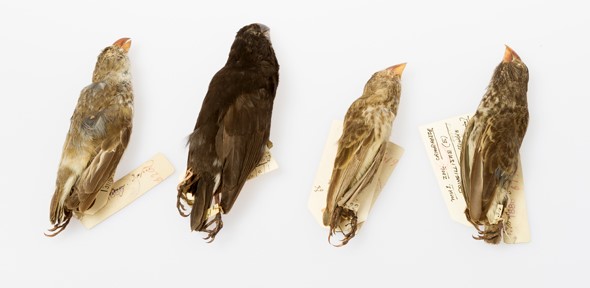CONTENT AVAILABLE ONLY IN ENGLISH
New research reveals that biodiversity ‘hotspots’ in the tropics produced new species at faster rates over the last 25 million years, but those in temperate regions are instead full of migrant species that likely sought refuge from shifting and cooling climates.


Some corners of the world teem with an extraordinary variety of life. Charles Darwin noted that: “The same spot will support more life if occupied by very diverse forms.”
The question of how these ‘hotspots’ of biodiversity – from California to the Galapagos – acquired such a wealth of species has long puzzled naturalists.
Now, scientists at the University of Cambridge have conducted a ‘big data’ study of almost all the world’s mammal and bird species to reveal the answer – and it’s very different depending on climate.
According to the study, tropical hotspots close to the equator have generated new species at a much faster rate than their surrounding areas during the last 25 million years of evolution.
However, biodiversity hotspots in more temperate northerly regions, such as the Mediterranean basin and Caucasus Mountains, are mainly populated with immigrant species that originated elsewhere.
Scientists say these migrants may well have been escaping the effects of long-term “geological processes” such as vast encroaching glaciers. Warmer climes, as well as peninsulas and mountain ranges, could have offered shelter.
The researchers argue that their new study, published today in the journal Science Advances, shows how these “contrasting macroevolutionary routes” have shaped the uneven distribution of species across the planet.
“We’ve known for decades that just a subset of places on Earth, no more than 20%, contain about half of all vertebrate species. However, we lacked the tools and data to understand why these patterns exist,” said senior author Dr Andrew Tanentzap, from Cambridge’s Department of Plant Sciences.
“Large-scale initiatives to map species across the planet and in the Tree of Life, as well as advances in computing, are expanding our understanding of evolution in exciting ways. This study can now provide an answer to the old question of why diversity varies so much across the world.”
Cambridge scientists used new computational techniques to combine several giant datasets. These included the global distribution of 11,093 bird species and 5,302 mammals, and detailed evolutionary trees that track the origin of thousands of organisms through deep time.
In this way, the researchers were able to analyse the development of particularly species-rich areas within each of the Earth’s great “biogeographical regions” – from Australasia to the Nearctic.
They found that biodiversity hotspots in the tropics, such as South American forests and Indonesian islands, had higher rates of “speciation” – the formation of new and distinct species – over the last 25 million years.
For example, speciation rates for birds in hotspots of the Indo-Malay region were, on average, 36% higher than that region’s non-hotspot areas. Hotspots in the Neotropics had almost 28% greater bird speciation compared to non-hotspots.
“Species generation is faster in the tropics, but we can now see it is extra-quick in these hotspots of biodiversity,” said study lead author Dr Javier Igea, also from Cambridge’s Department of Plant Sciences.
“More rainfall and hotter temperatures bolster the ecosystems of tropical hotspots, producing more plants, more animals that feed on those plants, and so on,” he said.
“The greater available energy and range of habitats within these hotspots supported the acceleration of species diversification.”
The tropical hotspot of Madagascar, for example, holds 12 species of true lemur that diversified in the last ten million years. All of the 17 species of earthworm mice endemic to the Philippines were generated in the last six million years.
The famously diverse finches Darwin found in the Galapagos Islands, as featured in his revolutionary book On the Origin of Species, are an iconic example of rapid speciation in a tropical hotspot.
However, when it came to the more temperate regions of the Nearctic (North America) and Palearctic (Eurasia and North Africa), the researchers discovered a different story.
While the hotspots of these regions also had a wider range of resource and habitat than neighbouring areas, the data from the evolutionary – or phylogenetic – trees revealed that most of their animals “speciated” somewhere else.
“Biodiversity hotspots in temperate zones have been shaped mainly by migration that occurred during the last 25 million years,” said Igea.
“We suspect that this influx of immigrant species resulted from climate fluctuations across millions of years, particularly cooling. Biodiversity hotspots may have acted as a refuge where more species could survive in harsh climatic conditions,” he said.
Igea points to species such as the Iberian lynx, now a native of the Mediterranean Basin hotspot, but found in central Europe during the Pleistocene – prior to the last Ice Age.
Or the yellow-billed magpie, which became isolated in California after becoming separated from its ancestral species – most likely due to glaciations – over three million years ago.
“We found that hotspots across the world all have a greater complexity of habitats and more environmental energy, but the processes that drive the biodiversity are very different for tropical and temperate zones,” Igea said.
For Tanentzap, the importance of species migration in temperate regions suggests that maintaining connectivity between hotspots should be a priority for future conservation efforts.
“Many of these hotspot regions have species found nowhere else on Earth, yet face devastating levels of habitat loss. Protecting these areas is vital to conserving the natural world’s diversity,” he said.






